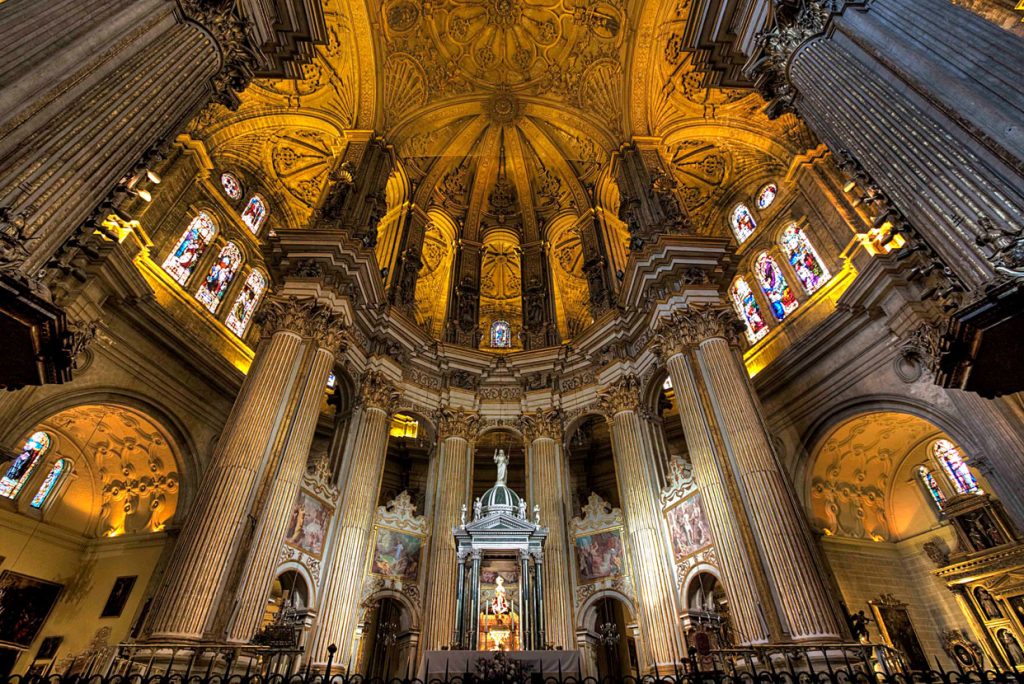History of Málaga Cathedral
Málaga Cathedral is one of the most impressive and beautiful buildings in the city of Málaga, Spain. It is also known as Santa María de la Encarnación, or simply La Manquita, which means “the one-armed lady” in Spanish. Why does it have such a curious nickname? And what makes this cathedral so special and worth visiting? In this blog, I will tell you everything you need to know about Málaga Cathedral, its history, its architecture, and its attractions.
A Brief History of Málaga Cathedral
Málaga Cathedral has a long and fascinating history that spans over four centuries. It was built on the site of a former mosque, which was demolished after the Christian reconquest of Málaga in 1487. The construction of the cathedral began in 1528, under the orders of the Catholic Monarchs, Ferdinand and Isabella, who wanted to create a magnificent Gothic temple to symbolize their victory over the Moors.
However, the project was soon abandoned and resumed in 1550, when the Renaissance and Baroque styles were more fashionable. The cathedral was designed by several architects, such as Diego de Siloé, Andrés de Vandelvira, and José de Bada, who gave it a harmonious and elegant appearance. The cathedral was built with stone from the quarries of the Axarquía region, and decorated with sculptures, paintings, and stained glass windows.
The construction of the cathedral lasted for more than 200 years, until 1782, when it was stopped due to lack of funds and political instability. As a result, the cathedral was left unfinished, with only one tower completed out of the two that were planned. The missing tower gave the cathedral its nickname of La Manquita, which is still used today. The cathedral was consecrated in 1829, and declared a National Monument in 1931.

The Architecture and Art of Málaga Cathedral
Málaga Cathedral is a remarkable example of the fusion of different artistic styles and influences. It has a Latin cross floor plan, with three naves, a transept, and a polygonal apse. The main facade, facing the Plaza del Obispo, is a masterpiece of the Spanish Renaissance, with a richly decorated portal and a large rose window. The facade is flanked by two towers, one of which is 84 meters high and the other is only 25 meters high and unfinished.
The interior of the cathedral is equally impressive, with a height of 41 meters and a length of 116 meters. The central nave is the widest in Spain, with a width of 22 meters. The naves are separated by Corinthian columns and covered by vaulted ceilings. The choir, located in the center of the nave, is a splendid work of art, with 42 carved wooden stalls and an organ with more than 4,000 pipes. The altar, behind the choir, is a Baroque masterpiece, with a marble tabernacle and a silver monstrance.
The cathedral also has 15 chapels, dedicated to different saints and patrons, each with its own artistic and historical value. Some of the most notable chapels are:
- The Chapel of the Incarnation, which houses the tomb of the bishop who initiated the construction of the cathedral, Diego Ramírez de Villaescusa.
- The Chapel of the Rosary, which contains a painting of the Virgin of the Rosary by Alonso Cano, and a sculpture of Christ of the Good Death by Pedro de Mena.
- The Chapel of the Trinity, which has a painting of the Holy Trinity by Bartolomé Esteban Murillo, and a sculpture of the Immaculate Conception by José de Mora.
- The Chapel of the Sacrament, which has a painting of the Last Supper by Juan Niño de Guevara, and a sculpture of the Virgin of Sorrows by Francisco Palma Burgos.
Visiting Málaga Cathedral
Málaga Cathedral is a must-visit attraction for anyone who visits the city. It is located in the heart of the historic center, near the Alcazaba, the Roman Theater, and the Picasso Museum. It is open to the public from Monday to Friday, from 10:00 to 18:00, and on Saturdays, from 10:00 to 17:00. The entrance fee is 8 euros for the cathedral only, or 12 euros for the cathedral and the rooftops combo ticket. The rooftops tour is a unique opportunity to enjoy the panoramic views of the city and the sea, and to admire the architecture and the details of the cathedral from above.
If you don’t have time to visit the inside of Málaga Cathedral, you can see up close its unique features from the exterior. Just in front of the main entrance to the cathedral is a charming small square with an old fountain. This is a great place to stop for a drink or enjoy a meal whilst having a front seat view to marvel at this historic building.
Málaga Cathedral is not only a religious and cultural monument, but also a living and active place, where concerts, exhibitions, and ceremonies are held throughout the year. It is a symbol of the history and identity of Málaga, and a testimony of the artistic and architectural heritage of Spain. If you are looking for a memorable and inspiring experience, do not miss the chance to visit Málaga Cathedral, the one-armed lady of the city.







